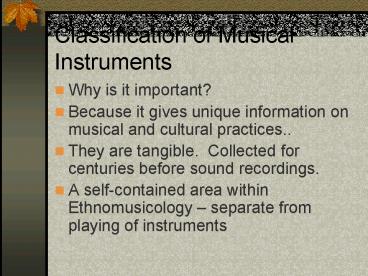Classification of Musical Instruments - PowerPoint PPT Presentation
1 / 8
Title:
Classification of Musical Instruments
Description:
Collected for centuries before sound recordings. ... self-contained area within Ethnomusicology separate from playing of instruments ... – PowerPoint PPT presentation
Number of Views:1061
Avg rating:3.0/5.0
Title: Classification of Musical Instruments
1
Classification of Musical Instruments
- Why is it important?
- Because it gives unique information on musical
and cultural practices.. - They are tangible. Collected for centuries
before sound recordings. - A self-contained area within Ethnomusicology
separate from playing of instruments
2
Why is it so important?
- Classifications serve the purpose of enabling
members of a culture to recognise fundamental
musical, social, and other relations between the
instruments and to formulate new myths or
theories. - Gender often plays a big role and instrument
classification give all sorts of insights into
musical traditions.
3
Early Systems
- Ancient Chinese based on material gourd,
skin, bamboo, wood, stone, metal, clay, silk. - Pre-1880s European back to the Greeks and
separation into wind and string. Then added
percussion with Virdung 1511, Agricola 1523,
Praetorius 1619, Mersenne 1630.
4
1880s and the Brussels Conservatiore
- Victor Charles Mahillon advocated a system based
on materials made to sound in the first instance.
Chordophones, Membraphones, Aerophones,
Autophones (latter changed to Idiophones). - Ideas taken up and developed by Sachs and Von
Hornborstal.
5
Hornborstal Sachs System
- Mahaillons ideas added to the Dewey decimal
system used by libraries. - Each of the 4 (now 5 with electrophones) major
areas have sub areas based on the way they are
made to sound . E.g. Aerophones divide into 6
major categories Single Reed, Double Reed, Edge
(whistle), Free Reed, Free Aerophones, Blow Hole
Strings divide into Zithers, Lutes, Lyres, Harps.
- The Dewey system allows new categories to be
made. 1 idiophones, 11 struck idiophones,
111 struck idiophones hit directly. A piano is
314.122-6-8
6
Problems with H/S
- Observant imposed not culture emergent.
- Not logical lots of instruments fall into
several major categories, ignored acoustical
properties. - Ignores the folk view
7
Proposed Systems since 1914
- Shaeffner 1932 system was based on medium gas,
solids (tensil, non-tensil, flexible) Galpins
system, Hoods based on Labannotation. - Ethno-theories aurally transmitted, natural and
indigenous. - Systems based on taxonomies and paradigms that
are logical and symmetrical and which are
specific to a culture
8
Ethno Theories indigenous taxonomies
- Downward/upward
- Based on numbers of levels/steps
- Symmetry
- Paradigms/mandola chinese, indian, javanese
- E.g. the Areare culture of Pacific based on
solo/ensemble capacity to play a melody
(equihephatonic, seconds or thirds degree of
magic blown or beaten, all expressed in bamboo
morphology can be put together in a tree
diagram or imperfect paradigm.

